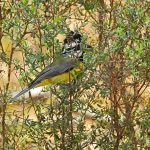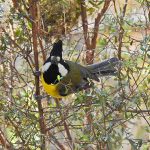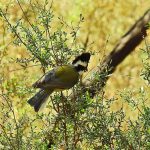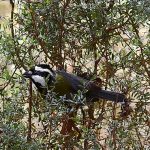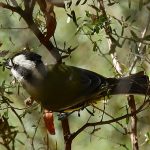CRESTED SHRIKETIT
The Crested Shrike-tit is a member of the family Pachycephalidae, which includes several species of shrike-tits and allies. It is a small to medium-sized bird, measuring about 19 to 22 cm in length. It has a distinctive crest on its head, which gives it its name. Its plumage is mainly black, with white markings on its face, throat, and wings.
This species is endemic to Australia and is found in various parts of the country, particularly in the eastern and south-eastern regions where they inhabit a range of forested habitats, including eucalyptus woodlands, rainforests, and scrublands. They are often found in dense vegetation and are known for their agile and acrobatic movements as they forage for insects and small invertebrates.
Crested Shrike-tits are known for their distinctive “shrike” behavior. Like true shrikes, they impale their prey (insects and small vertebrates) on thorns or sharp branches, creating a larder for later consumption. They have sharp bills adapted for this behavior.
Crested Shrike-tits have a melodious and distinctive call, which consists of a series of musical notes. Their calls are often used for communication within their family groups.
Crested Shrike-tits are typically seen in family groups, including breeding pairs and their offspring. They are known to be cooperative breeders, with older siblings helping to raise younger chicks.
The northern subspecies of the Crested Shrike-tit, whitei, is endangered, occurring at such low densities in some areas that populations may not be able to renew themselves and are isolated from each other. More frequent, hot fires in the dry season decrease the ability of insects to establish themselves under bark, reducing the Shrike-tit’s main food source. The near-threatened western subspecies, leucogaster, is affected by land-clearing in the wheat belt, where it is unable to survive even in large remnant vegetation patches. The eastern subspecies, frontatus, is probably affected adversely by urban development. It was formerly common in Sydney Harbour National Park, but has not been reported there recently.
References
Higgins, P.J. and J.M. Peter (eds) 2002. Handbook of Australian, New Zealand and Antarctic Birds, Volume 6: Pardalotes to Shrike-thrushes. Oxford University Press, Melbourne.

